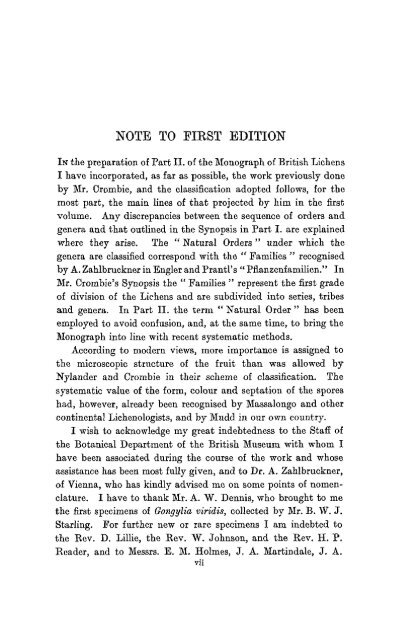- Page 1: BRITISH LICHENS
- Page 4 and 5: PRINTED IN GREAT BRITAIN BY RWR"RD
- Page 8: viii NOTE TO SECOND EDITION Wheldon
- Page 14 and 15: 4 CYCLOCAl'INEAll GYALECT Var. doli
- Page 16: 6 CYCLOCARPINElE GYALECTA Hab. On c
- Page 21 and 22: LECIDEA LECIDEACElE 11 An inconspic
- Page 25: Lt
- Page 30 and 31: 20 CYCLOCARPINEllE Ll!lClDEA age, m
- Page 33: LECIDEA LECIDEACElE 23 line. The ap
- Page 40: ao CYdLOC.ARPINElE LECIDEA the apic
- Page 51 and 52: LECIDEA LECIDEACElE 41 Distinguishe
- Page 55 and 56: LECIDEA LECIDEACElE 45 the S. Gramp
- Page 57 and 58:
LECIDEA LECIDEACE.iE 47 Somewhat li
- Page 59:
LECIDEA LECIDEACEJE 49 Considered b
- Page 62 and 63:
52 CYCLOCARPINElE LECIDEA epitheciu
- Page 65 and 66:
LECIDEA LECIDEACEiE 55 internally w
- Page 68 and 69:
58 CYCLOCARPINE;E LECIDEA Differs f
- Page 71:
LE0IDEA r,ECIDEACElE 61 or somewhat
- Page 75:
LECIDEA LECIDElACEM Gil 107. L. lap
- Page 81 and 82:
LECIDEA LECIDEACEA!: 71 8 ..... 11
- Page 84 and 85:
71 CYCLOCARPINEiE LECIDEA rimose-ar
- Page 87:
LECIDEA LECIDEACELE 77 In the Br;ti
- Page 92 and 93:
82 CYCLOCARPINElE LEctDla 141. L. p
- Page 97:
LECIDEA LECIDEAOElE 87 parte; Hook.
- Page 108:
98 CYCLOCARPINElE LECIDEA parte; ed
- Page 111:
LECIDEA LECIDEACElE 101 more or les
- Page 114 and 115:
101 CYCLOCARPINElE LECIDEA 187. L.
- Page 116:
106 CYCLOCARPINElE LECIDEA subplane
- Page 120:
110 CYCLOCARPINElE LECIDEA black, s
- Page 124:
114 CYCLOCARPINEiE LECIDEA L. affin
- Page 130 and 131:
120 CYCLOCARPINElE BIATORELLA Lamy
- Page 136 and 137:
126 CYCLOCARPINEA
- Page 142:
132 CYCLOCARPINEJE BIATORINA Var. b
- Page 153:
BIATORINA LECIDEACElE 14.3 Living o
- Page 163 and 164:
BILIMBIA LECIDEACElE 153 Var. albor
- Page 169:
BILIMBIA 159 25. B. mel rena Arnold
- Page 172:
162 .CYCLOCARl'tNElE BILtMBIA conve
- Page 175 and 176:
BAOIDIA LECIDEACEJE 165 Var. porrig
- Page 177:
BACIDIA LECIDEACEJE 167 more nearly
- Page 180:
170 CYCLOCARPINElE BACIDIA f. inund
- Page 187:
BAOtDIA LECIDEACElE 177 thick.-Pate
- Page 197 and 198:
BUELLIA . LECIDEACEA> 187 brown or
- Page 204 and 205:
194 CYOLOCARPINElE BUELLIA 26. B. l
- Page 208:
198 CYCLOCARPINEAl: RUELLIA hymenia
- Page 221:
RHIZOCARPON LECIDEACEAi: 211 Leight
- Page 229:
DIRINA DIRINACEJE 219 A small famil
- Page 240:
230 GRAPHIDlNElE ARTHONIA Well dist
- Page 245 and 246:
ARTHONIA ARTHONIACEJE 235 14. A. dc
- Page 250:
240 GRAPHIDINEAJ: ARTHONIA 23. A. L
- Page 254 and 255:
244 GRAPHIDINEJE LTTHOGRAPHA Capel
- Page 257:
XYLOGRAPHA GRAPHIDACElE 247 Hab. On
- Page 263:
OPEGRAPHA GRAPHIDACEJE 253 to O. he
- Page 267:
OPEGRAP!IA (jRAP!IIDACE2E 257 4 [1.
- Page 270 and 271:
260 GRAPIDDINEjE OPEGRAPRA Exsicc.
- Page 273 and 274:
OPEGRAPHA GRAPHIDACE.IE 263 margins
- Page 275 and 276:
OPEGRAPHA GRAPHIDACEJE 265 Hab. On
- Page 278:
268 GRAPIDDINEAll OPEGRAPHA The spe
- Page 286 and 287:
276 G itAPIi:mINElE PttJEOGRAl>ttIS
- Page 290:
280 G RAPHIDINElE GRAPHINA simple o
- Page 300 and 301:
290 PYRE NOCARP:gA
- Page 307:
ENDOCARPON DERMATOCARPACE.iE 297 th
- Page 320 and 321:
310 PYRENOCARPElE VERRUCARIA 21. V.
- Page 323:
VERRUCARIA VERRUCARIACElE 313 deter
- Page 332:
322 PYRENOCARPElE VERRUCARIA (paras
- Page 339 and 340:
POL YBLASTIA VERR UCARIACE.'E 329 I
- Page 341 and 342:
POL YBLASTIA VERRUCARIACELE 331 Nyl
- Page 343:
POL YBLASTJA VERRUCARIACElE 333 Mem
- Page 348 and 349:
338 PYRENOCARPElE MICROGLlENA 2. M.
- Page 352:
342 PYRENOCARPElE STAUROTHELE rupif
- Page 355:
ACROCORDIA PYRENULACEiE 345 ellipso
- Page 361 and 362:
ARTHOPYRENIA PYRENULACElE 351 7. A.
- Page 363:
ARTHOPYRENIA PYRENULACE.al: 353 11.
- Page 367:
ARTHOPYRENIA PYRENULACElE 357 is do
- Page 370 and 371:
360 PYRENOCARPElE ARTHOPYRENIA Ofte
- Page 372 and 373:
362 PYRENOCARPElE LEPTORHAPHIS Peri
- Page 374:
364 PYRENOCARPElE MICROTHELIA The s
- Page 377:
PORINA PYRENULACEiE 367 Perithecia
- Page 383 and 384:
CLATHROPORINA PYRENULACElE 373 1. C
- Page 385 and 386:
PYRENULA PYRE NULACElE 375 Bot. iii
- Page 388 and 389:
378 . PYRENOCARPEJE THELOCARPON one
- Page 391:
JIIYCOPORUM MYCOPORACEl.E 381 and I
- Page 401 and 402:
ADDENDA AND CORRIGENDA P. 122. Unde
- Page 403 and 404:
APPENDIX 393 255; ed. 3, 246; A. L.
- Page 405 and 406:
APPENDIX 395 A. smaragdula and somc
- Page 407:
APPENDIX 397 " Pycnidia " minute, n
- Page 410 and 411:
400 APPENDIX Lichens. "We are indeb
- Page 412 and 413:
402 APPENDIX Family XV A. CHRYSOTHR
- Page 415 and 416:
GLOSSARY ABRADED (Lat abrado, to ru
- Page 417 and 418:
GLOSSARY CORIACEOUS (Lat. corium, l
- Page 424 and 425:
414 GLOSSARY TERIIIINAL (Lat. termi
- Page 427:
aphorisasa A. L. Sm. (Arthopyrcnia)
- Page 434 and 435:
424 INDEX dispersa Duf. (Arlhonia),
- Page 441:
INDEX lretevirens Ny!. (Normandina)
- Page 447 and 448:
iNDEX parallela Schaer. (Opegrapha
- Page 450:
440 INDEX RACODIUM Pers., 2 radiata
- Page 458 and 459:
PRINTED IN GREAT BRITAIN l!Y 1l1l.:
- Page 460 and 461:
•
- Page 463:
a d x 50 GYALEOTA UUPULARIB Bohrer
- Page 468:
•
- Page 481:
e x 600 a f (700 c x 600 BUELLIA lH
- Page 493:
d x 40 x :WOO f x 500 x 500 ROCCELL
- Page 513:
(I /:, 1 x 100 r \ I \ ( ,; 1.1 I \
- Page 528:
· "
- Page 541:
- , x 800 c x 600 ENDOCAltPON PUSIL
- Page 545:
a d x 100 , I ,', , e b x 550 SARCO
- Page 557 and 558:
a .I I \ :.,1 ) ./ (.,; ) CiJ .,:;,
- Page 567:
e \ \ x 600 A I x 1200 POIU.NA OLIV
- Page 582:
, "

















